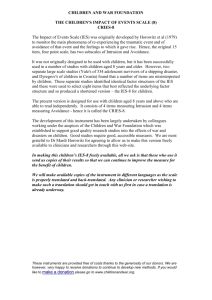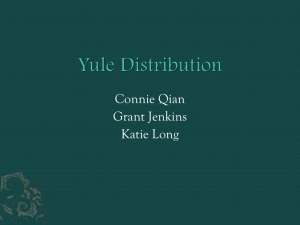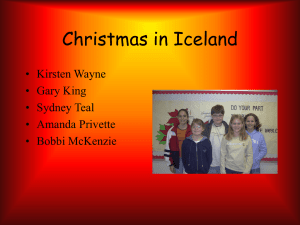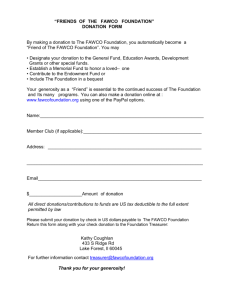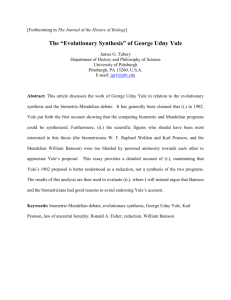Instruction and English version
advertisement
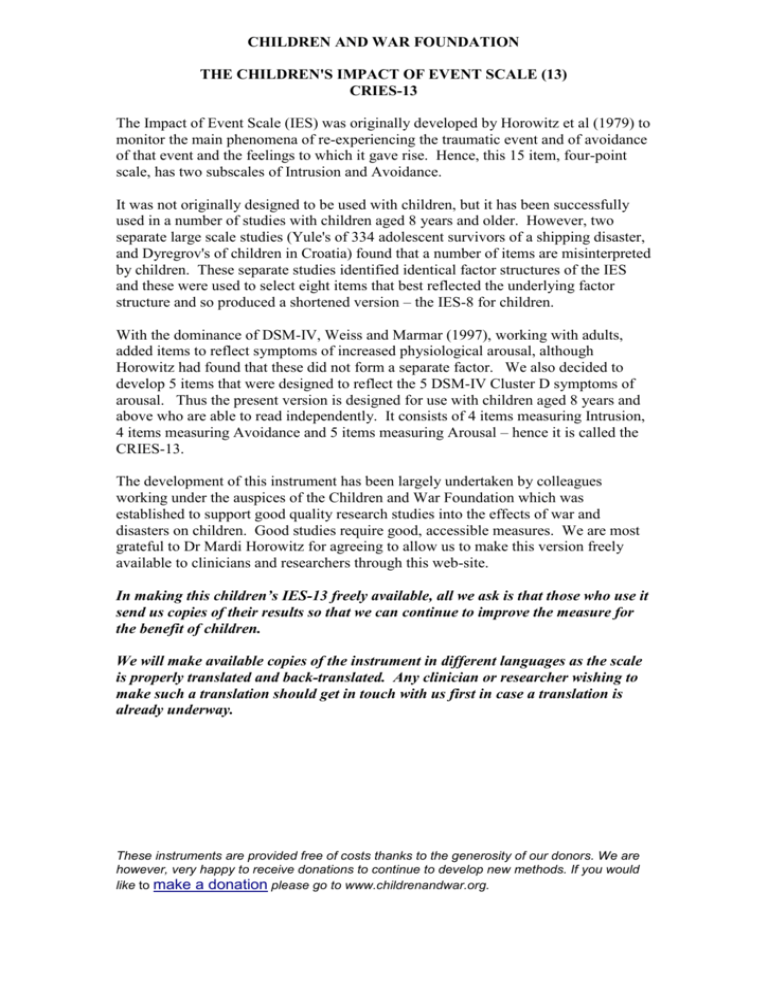
CHILDREN AND WAR FOUNDATION THE CHILDREN'S IMPACT OF EVENT SCALE (13) CRIES-13 The Impact of Event Scale (IES) was originally developed by Horowitz et al (1979) to monitor the main phenomena of re-experiencing the traumatic event and of avoidance of that event and the feelings to which it gave rise. Hence, this 15 item, four-point scale, has two subscales of Intrusion and Avoidance. It was not originally designed to be used with children, but it has been successfully used in a number of studies with children aged 8 years and older. However, two separate large scale studies (Yule's of 334 adolescent survivors of a shipping disaster, and Dyregrov's of children in Croatia) found that a number of items are misinterpreted by children. These separate studies identified identical factor structures of the IES and these were used to select eight items that best reflected the underlying factor structure and so produced a shortened version – the IES-8 for children. With the dominance of DSM-IV, Weiss and Marmar (1997), working with adults, added items to reflect symptoms of increased physiological arousal, although Horowitz had found that these did not form a separate factor. We also decided to develop 5 items that were designed to reflect the 5 DSM-IV Cluster D symptoms of arousal. Thus the present version is designed for use with children aged 8 years and above who are able to read independently. It consists of 4 items measuring Intrusion, 4 items measuring Avoidance and 5 items measuring Arousal – hence it is called the CRIES-13. The development of this instrument has been largely undertaken by colleagues working under the auspices of the Children and War Foundation which was established to support good quality research studies into the effects of war and disasters on children. Good studies require good, accessible measures. We are most grateful to Dr Mardi Horowitz for agreeing to allow us to make this version freely available to clinicians and researchers through this web-site. In making this children’s IES-13 freely available, all we ask is that those who use it send us copies of their results so that we can continue to improve the measure for the benefit of children. We will make available copies of the instrument in different languages as the scale is properly translated and back-translated. Any clinician or researcher wishing to make such a translation should get in touch with us first in case a translation is already underway. These instruments are provided free of costs thanks to the generosity of our donors. We are however, very happy to receive donations to continue to develop new methods. If you would like to make a donation please go to www.childrenandwar.org. Administration The IES is self completed and can therefore be administered in groups. Scoring There are 8 items that are scored on a four-point scale: Not at all Rarely Sometimes Often =0 =1 =3 =5 There are three sub-scales: Intrusion = sum of items 1+4+8+9 Avoidance = sum of items 2+6+7+10 Arousal = sum of items 3+5+11+12+13 The layout has been designed so that scoring can be easily done in the three columns on the right hand side. The total for each sub-scale can be entered at the bottom of each column. Evaluation and psychometric status At this point in time (June 2003), only one published study has used the 13-item version. Psychometric data relevant to the reliability and validity of the 8-item version were presented in Yule (1997). There, it was reported that the total score on the 8-item IES correlated highly with the total score on the 15-item version of which it was part (r = +.95, P <. 001). The two versions of IES correlated with a symptom count based on the number of DSM symptoms present in adolescents following an acute trauma as follows: 15-IES = 0.7551; 8-IES, r = 0.6970. Thus, on this relatively independent measure, the short form still correlates very highly and there is not too much attrition with the shorter scale. In an analysis of the scores of 87 survivors of the sinking of the Jupiter, it was found that the 62 children who received a DSM diagnosis of PTSD scored 26.0 on the 8item version while the 25 who did not reach DSM criteria for a diagnosis of PTSD only scored 7.8 (P < 0.001). Using these data, it was found that a combined score (Intrusion + Avoidance) of 17 or more misclassified fewer than 10% of the children. The 13-item version was used in a survey of 2,976 children aged 9-14 years who had experienced the war in Mostar, Bosnia (Smith, Perrin, Dyregrov and Yule, 2002). The scale was translated into Bosnian and back-translated by a separate Bosnian These instruments are provided free of costs thanks to the generosity of our donors. We are however, very happy to receive donations to continue to develop new methods. If you would like to make a donation please go to www.childrenandwar.org. speaker to establish its accuracy. No major differences were found between boys and girls in respect of the factors identified and so only the total results are presented here. The Scales had satisfactory internal consistency. Cronbach alphas were as follows: Intrusion = 0.70; Avoidance = 0.73; Arousal = 0.60; Total = 0.80 The analysis revealed a three-factor solution corresponding to the three hypothesised sub-scales. The solution accounted for 49.3% of the total variance. Despite the theoretical criticisms often made against using such self-completed scales in different cultures, the IES has now been applied in a variety of cultures, including studies with children. It is now clear that posttraumatic stress symptoms in children are more similar across cultures than they are different. Indeed, Intrusion and Arousal are robust factors of the Impact of Event Scale in children from different cultures. We remind people using the scales that one cannot make a clinical diagnosis from scores on the self-completed scales alone. A proper clinical diagnosis relies on much more detailed information obtained from a structured interview that assesses not only the presence and severity of stress symptoms, but also the impact on the child’s overall social functioning. At present, there are no studies that have used the IES-13 and validated it against an independent clinical diagnosis. Therefore, for screening purposes we recommend that people use the results from the Intrusion and Avoidance scales only. If the sum of the scores on these two scales is 17 or more, then the probability is very high that that child will obtain a diagnosis of PTSD. References: Dyregrov, A., Kuterovac, G. & Barath, A.(1996) Factor analysis of the Impact of Event Scale with children in war. Scandinavian Journal of Psychology, 36, 339-350. Horowitz, M. J., Wilner, N., and Alvarez, W. (1979). Impact of event scale: A measure of subjective stress. Psychosom.Med., 41, 209-218 Kuterovac, G., Dyregrov, A.& Stuvland, R. (1994) Children in war: A silent majority under stress. British Journal of Medical Psychology, 67, 363-375. Smith, P., Perrin, S., Dyregrov, A. & Yule, W. (2002) Principal components analysis of the Impact of Event Scale with children in war. Personality and Individual Differences, Weiss, D. S., & Marmar, C. R. (1997). The impact of event scale-revised. In J. P. Wilson, & T. M. Keane (Eds.), Assessing Psychological Trauma and PTSD. New York: The Guilford Press. These instruments are provided free of costs thanks to the generosity of our donors. We are however, very happy to receive donations to continue to develop new methods. If you would like to make a donation please go to www.childrenandwar.org. Yule, W. (1992) Post Traumatic stress disorder in child survivors of shipping disasters: The sinking of the "Jupiter". J. Psychother. Psychosomatics, 57, 200-205. Yule, W. (1997) Anxiety, Depression and Post-Traumatic Stress in Childhood. In I. Sclare (Ed) Child Psychology Portfolio. Windsor: NFER-Nelson Yule, W., Ten Bruggencate, S & Joseph, S. (1994) Principal components analysis of the Impact of Event Scale in children who survived a shipping disaster. Personality and Individual Differences, 16, 685-691. CRIES-13 Revised Child Impact of Event Scale Below is a list of comments made by people after stressful life Event. Please tick each item showing how frequently these comments were true for you during the past seven days. If they did not occur during that time please tick the ‘not at all’ box. Name: …………………………………………… Date: ……… Office use only Not at all Rarely Sometimes Often 1. Do you think about it even when you don’t mean to? [ ] [ ] [ ] [ ] 2. Do you try to remove it from your memory [ ] [ ] [ ] [ ] 3. Do you have difficulties paying attention or concentrating [ ] [ ] [ ] [ ] 4. Do you have waves of strong feelings about it [ ] [ ] [ ] [ ] 5. Do you startle more easily or feel more nervous than you did before it happened? [ ] [ ] [ ] [ ] 6. Do you stay away from reminders of it (e.g. places or situations) [ ] [ ] [ ] [ ] 7. Do you try not talk about it [ ] [ ] [ ] [ ] 8. Do pictures about it pop into your mind? [ ] [ ] [ ] [ ] These instruments are provided free of costs thanks to the generosity of our donors. We are however, very happy to receive donations to continue to develop new methods. If you would like to make a donation please go to www.childrenandwar.org. In Av Ar 9. Do other things keep making you think about it? [ ] [ ] [ ] [ ] 10. Do you try not to think about it? [ ] [ ] [ ] [ ] 11. Do you get easily irritable [ ] [ ] [ ] [ ] 12. Are you alert and watchful even when there is no obvious need to be? [ ] [ ] [ ] [ ] 13. Do you have sleep problems? [ ] [ ] [ ] [ ] © Children and War Foundation, 1998 These instruments are provided free of costs thanks to the generosity of our donors. We are however, very happy to receive donations to continue to develop new methods. If you would like to make a donation please go to www.childrenandwar.org.
